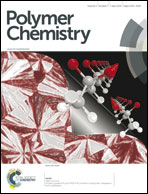Improving the electrical memory performance of pyrazoline moiety via the preparation of its hyperbranched copolymer†
Abstract
An organic small molecule 4-(1,3-diphenyl-4,5-dihydro-1H-pyrazol-5-yl)-N,N-dimethylaniline (ATPP) bearing a pyrazoline moiety was investigated as an electrical memory material. ATPP as an electro-active film was fabricated by thermal evaporation and then prepared as a sandwich memory device (ITO/ATPP/Al). The as-prepared device exhibited different memory behaviors from nonvolatile ‘switch-off’ to volatile static random access memory (SRAM) via decreasing the compliance currents from 0.1 A to 0.001 A. To avoid the switch-off phenomenon caused by the diffusion of aluminium (Al) atoms, a hyperbranched polystyrene (HPPS) through the copolymerization of ‘inimer’ based on ATPP and styrene using self-condensing vinyl polymerization (SCVP) was introduced herein. The hyperbranched structure of HPPS widened the distance between the inimers and reduced the possibility of Al atoms penetration. The HPPS-based memory device exhibited stable SRAM behavior, even at a compliance of 0.1 A with a low switching threshold voltage of about −2.5 V and an ON/OFF current ratio in excess of 104. The SRAM performance of ATPP and HPPS was attributed to the unstable electric-field-induced intramolecular charge transfer (ICT), which was verified by theoretical calculation and UV-vis spectra changes before and after applying the electric field.


 Please wait while we load your content...
Please wait while we load your content...